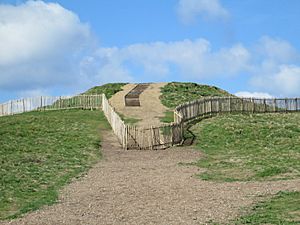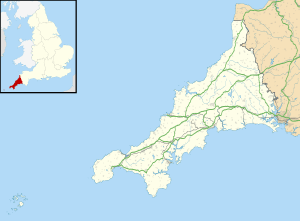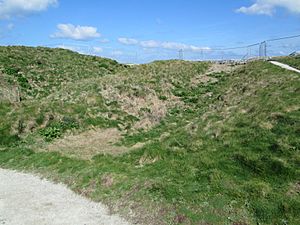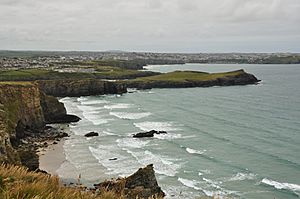Trevelgue Head facts for kids
Quick facts for kids Trevelgue Head |
|
|---|---|

The round barrow at the western end of the peninsula
|
|
| Location | Cornwall |
| OS grid | SW825630 |
| Coordinates | 50°25′37″N 5°03′46″W / 50.4269°N 5.0629°W |
| Designation | Scheduled monument |
Trevelgue Head, also known as Porth Island, is a piece of land that sticks out into the sea. It's called a headland. You can find it in Cornwall, England, near the town of Newquay. It sits right next to Porth at the eastern end of Newquay Bay.
This headland was once home to an Iron Age promontory fort. This means it was a strong, natural fortress. People built defensive walls and ditches here. You can also see two ancient burial mounds, called round barrows. These mounds are even older, dating back to the Bronze Age.
Exploring Trevelgue Head
Trevelgue Head is a peninsula, meaning it's land almost surrounded by water. It connects to the main land on its eastern side. On the south side, there's a natural harbour, which is a safe place for boats. Today, you can walk along the South West Coast Path around the eastern part of the headland.
On the east side, you can still see old defensive earthworks. These are like ancient walls made of earth. There's a single bank and ditch on the wider part of the peninsula. This area is also protected by tall sea-cliffs on the northern side.
There's a gap in the peninsula, which is now crossed by a modern bridge. Long ago, there might have been a land-bridge here. Before this gap, you can see three very large banks and ditches. These were built to protect the fort even more. Beyond the gap, there's another earth wall, and then a final one closer to the end of the headland.
Ancient Burial Mounds
Inside the fort's defenses, there are two Bronze Age round barrows. These are ancient burial mounds. One barrow is in the eastern area near the cliffs. It's about 18 metres (59 feet) across and 1.6 metres (5 feet) high. The other barrow is at the highest point of the peninsula, near the western end. This one is larger, about 25 metres (82 feet) across and 2.5 metres (8 feet) high.
Discovering the Past
Archaeologists have studied Trevelgue Head to learn about its history. In 1939, C. K. Croft Andrew led an excavation here. An excavation is when scientists carefully dig up old sites to find artifacts. This project had to stop because of World War II, so the findings weren't fully shared at the time.
Later, in 1997, scientists looked at the main discoveries again. Then, in 2011, the Cornwall Archaeological Unit published a book about the site. It explained how important the 1939 excavations were for understanding ancient Cornwall.
What Was Found
Scientists found clues that people lived at Trevelgue Head even in the Mesolithic period. This was a very long time ago! But most of the exciting discoveries are from the Iron Age.
They found the foundations of roundhouses from the 2nd century BC. These were circular homes. The biggest one was about 14.5 metres (48 feet) across. It had a ring of seven or eight postholes, which held up the roof, and a central fireplace. This building was one of the largest roundhouses ever found in Cornwall. It might have been a meeting place for the community, not just a home.
Archaeologists also found proof that people worked with metals here. They discovered furnaces, pits for roasting ore, and about 200 kilograms (440 pounds) of iron slag. Slag is a waste product from melting metal. They also found about 600 pieces of worked stone, over 4,000 pieces of pottery, and objects made of tin, copper, iron, and glass. These finds tell us a lot about how people lived and worked thousands of years ago!




